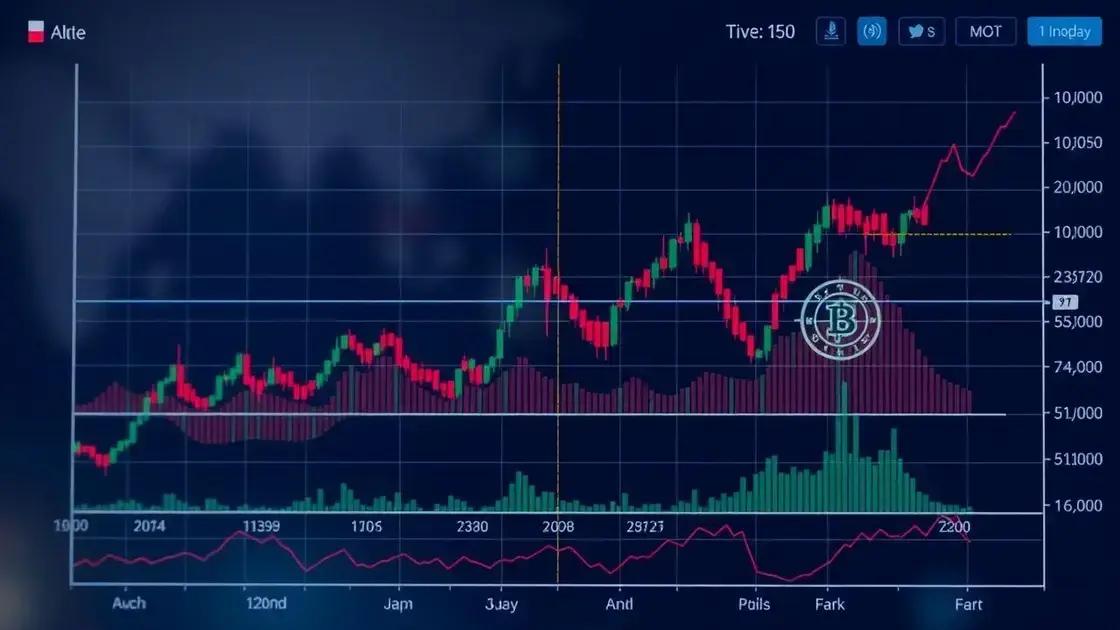Market outlook analysis: Bessent weighs in on trade

Anúncios
Navigating market uncertainties requires effective strategies such as diversification, regular monitoring of trends, and setting clear investment goals to minimize risk and maximize opportunities.
Market outlook analysis: If you’re curious about the latest trends in trade and economics, you’re in the right place. With experts like Bessent weighing in, understanding these dynamics is crucial for navigating today’s market.
Anúncios
Understanding Bessent’s market outlook
Understanding Bessent’s market outlook is essential for grasping the current economic climate. His insights provide valuable perspectives on trade and monetary policy that influence various markets.
Key Elements of Bessent’s Analysis
Bessent focuses on several critical factors affecting the market. These include shifts in trade agreements, interest rates imposed by central banks, and economic performance indicators. Each plays a vital role in shaping investor sentiment.
Anúncios
- Trade Agreements: Recent developments in trade agreements have created both opportunities and challenges.
- Interest Rates: Changes in interest rates can lead to significant fluctuations in market performance.
- Economic Indicators: Bessent closely watches GDP growth, unemployment rates, and consumer spending.
These elements create a framework for understanding potential market movements. For instance, if trade tensions rise, markets may react negatively, prompting investors to seek safer assets.
Impact on Portfolio Strategies
Considering Bessent’s insights is crucial for developing effective portfolio strategies. Investors should remain agile and analyze how different market dynamics interact with their investments. It’s important to be aware of potential risks and opportunities arising from these insights.
For example, in uncertain economic times, diversification becomes even more critical. By managing risk through a well-diversified portfolio, investors can better navigate the challenges posed by fluctuating markets.
In summary, approaching Bessent’s market outlook with an informed perspective enhances decision-making processes. Understanding the key elements he evaluates helps in crafting strategies that align with market conditions.
Impact of Powell on trade policies
The impact of Powell on trade policies is significant and multifaceted. As the Federal Reserve Chair, his decisions influence the direction of the economy and the trading environment.
Understanding Powell’s Role
Powell’s leadership at the Federal Reserve shapes key economic policies. He focuses on maintaining stable prices and maximum employment, which directly affects trade.
- Monetary Policy Adjustments: Changes in interest rates can alter the dollar’s strength, impacting international trade.
- Market Reactions: Traders often respond swiftly to Powell’s statements, adjusting their strategies based on anticipated economic conditions.
- Inflation Control: Powell aims to keep inflation in check, influencing trade relations with other countries.
This means that when Powell discusses rate changes, traders and businesses must prepare for the potential effects on their operations. For instance, a potential increase in interest rates could lead to a stronger dollar, making exports more expensive.
Trade Policies Under Powell
Powell’s influence extends to trade policies that the U.S. government adopts. His perspective can encourage or discourage free trade agreements, affecting global trade dynamics.
Powell supports policies that foster economic growth. His views often emphasize the importance of collaboration and trade with key partners. As such, dialogues surrounding tariffs and trade agreements are closely monitored.
In summary, understanding the impact of Powell on trade policies is essential for traders and businesses alike. By keeping an eye on Powell’s remarks, stakeholders can navigate the complex landscape of trade more effectively.
Dollar fluctuations and their implications

Dollar fluctuations are a common occurrence in global markets. Understanding these changes is important for various economic activities, from trading to investing.
Factors Influencing Dollar Value
Several factors can lead to fluctuations in the dollar’s value. Economic indicators, geopolitical events, and monetary policy decisions all play a crucial role.
- Economic Data: Reports on unemployment, inflation, and GDP can sway traders’ perceptions of the dollar.
- Central Bank Actions: Decisions made by the Federal Reserve, such as interest rate changes, can lead to immediate shifts.
- Global Events: Political instability or significant global events can create uncertainty, affecting dollar strength.
When the dollar strengthens, U.S. exports may become more expensive for foreign buyers, potentially decreasing demand. Conversely, a weaker dollar can make U.S. products cheaper internationally, boosting exports.
Impact on Trade and Investments
Fluctuations in the dollar can significantly influence trade and investment decisions. Companies engaged in international trade need to manage their exposure to currency risk. A sudden shift in the dollar can lead to financial losses or gains.
For investors, understanding dollar trends helps in making informed decisions. A strong dollar may represent stability, but it can also indicate potential issues in global competitiveness. Monitoring dollar fluctuations allows investors to adapt their strategies accordingly.
Overall, keeping an eye on dollar fluctuations and their implications is vital for anyone involved in cross-border transactions and investments.
Argentina’s economic challenges
Argentina faces significant economic challenges that affect its growth and stability. Understanding these issues is crucial for grasping the overall market dynamics.
High Inflation Rates
One major challenge is the persistent high inflation rate, which has plagued Argentina for years. Inflation erodes purchasing power and creates uncertainty in the market.
- Consequences: Consumers pay more for everyday goods, worsening living conditions.
- Business Impact: Companies struggle to plan budgets due to unpredictable costs.
- Investment Climate: Investors often shy away from a market with volatile inflation.
Such conditions can discourage both local and foreign investments, thereby hindering economic development.
Currency Devaluation
Another challenge is the devaluation of the Argentine peso. Frequent currency fluctuations create instability for businesses and consumers alike.
As the peso loses value, imported goods become more expensive, leading to increased inflationary pressures. This creates a vicious cycle that further complicates Argentina’s economic situation.
People often face financial stress due to these currency issues, prompting a lack of consumer confidence. Moreover, companies with international dealings must navigate this complex landscape carefully.
Debt Crisis
Argentina continues to grapple with a large national debt, which poses serious challenges. The government often finds itself in negotiations with creditors, affecting public services and infrastructure projects.
Debt repayment takes a significant portion of the national budget, restricting funds available for necessary programs. Consequently, social services, education, and healthcare can suffer.
Addressing these economic challenges requires comprehensive reforms and strategies that promote stability and growth.
Strategies for navigating market uncertainties
Navigating market uncertainties is essential for any investor or business. With the right strategies, one can effectively manage risks and seize opportunities.
Diversification
One of the most important strategies is diversification. By spreading investments across various asset classes, investors can reduce the impact of any single investment’s poor performance.
- Asset Classes: Consider stocks, bonds, real estate, and commodities.
- Geographical Spread: Invest in different regions to mitigate localized risks.
- Sector Diversification: Include multiple sectors to balance potential downturns.
This method helps in smoothing out returns and protecting against volatility.
Regular Monitoring
Another effective strategy is regularly monitoring market trends and economic indicators. Staying informed allows you to adjust your strategies in response to changing conditions.
Key indicators include interest rates, inflation rates, and employment statistics. Understanding these can provide insights into potential market movements.
By being proactive, investors can make quicker decisions during periods of uncertainty, enabling them to capitalize on emerging opportunities.
Setting Clear Goals
It’s crucial to establish clear investment goals. Clear goals guide decision-making and help maintain focus during turbulent times. Whether you’re seeking short-term gains or long-term growth, having a defined plan keeps you on track.
Additionally, setting risk tolerance levels can inform how much uncertainty you’re willing to accept. This clarity can help mitigate emotional responses during market fluctuations.
Adopting these strategies for navigating market uncertainties can significantly enhance your ability to adapt and succeed in ever-changing conditions.
Navigating market uncertainties can be challenging, but with the right strategies, investors can find success. By diversifying investments, monitoring trends, and setting clear goals, individuals and businesses can adapt to changing conditions. These practices help to minimize risks and maximize opportunities, making it easier to thrive even when markets are volatile. Staying informed and being proactive is the key to achieving financial stability and growth.
FAQ – Frequently Asked Questions about Navigating Market Uncertainties
What is diversification and why is it important?
Diversification is spreading investments across different assets to minimize risk. It helps protect against losses if one investment performs poorly.
How can I monitor market trends?
You can monitor market trends by following financial news, using analytics tools, and keeping an eye on key economic indicators like inflation and employment rates.
What should I do if I have a low risk tolerance?
If you have a low risk tolerance, focus on stable investments like bonds and consider diversifying across safer asset classes to reduce exposure.
Why is setting clear investment goals important?
Setting clear investment goals provides direction and helps you make informed decisions, especially during uncertain market conditions.






